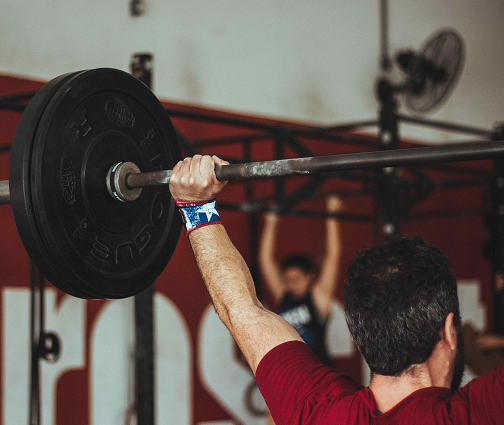
Barbell row is one of the main exercise methods for developing back muscles. It is named because its trajectory resembles a rowing action.
Bench presses and push-ups are classic exercises to show strength, and they practice mirror meat, so everyone likes them. However, if you practice too much, it will lead to an imbalance of muscle strength. Therefore, we need back training to balance. From the action point of view, bench presses and push-ups are all horizontal push (forward push) actions, so we need a horizontal pull (back pull) action. Barbell rows is a very good choice.
In this article you’re going to learn the benefits of doing barbell rows, what muscles do barbell rows work, how to do barbell rows, several mistakes you may make when barbell rows,10 of the best row variations, and more!
Benefits of barbell rows
1.Train the entire back muscles
Your upper back muscles are the active muscles of bar rowing, which are mainly responsible for generating movements. Latissimus dorsi trapezius, rhomboid and deltoid muscles are all involved in a large number of movements. And your lower back is also working hard at the same time, strong isometric contraction to maintain the stability and neutrality of the spine, avoiding the damage of the intervertebral disc, although the working style of the upper back muscles is different.
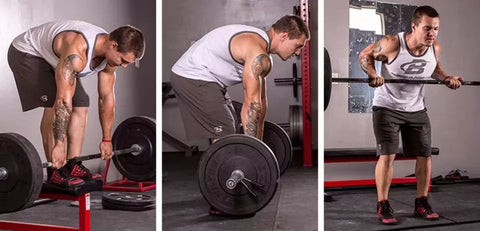
2.Barbell rowing to improve your deadlift
Deadlift and leaning rowing are both hip hinge actions. The most common difficulty in deadlifting is the position near the knees, and the angle of leaning over when you are doing barbell leaning rowing also falls near this.
In most failed deadlift attempts, it is stuck at the knee point. It is either too heavy or lacks sufficient core strength to stabilize the body. We also introduced the pause deadlift before, stopping at the difficult point. Maintaining tension helps to improve deadlift.
Imagine that if you remove the upper limb pulling action when leaning over and rowing, this is the position of a pause in the deadlift, so leaning over the barbell rowing will definitely help your deadlift.
3.Improve your core stability
Barbell rowing can help you build a strong core, because you need to activate your core muscles to maintain the stability of the torso and maintain the correct position, while rowing.
Barbell rowing will teach your core muscles to work together under stress to maintain a neutral spine and correct hip position. If your core is insufficient and your spine cannot maintain the correct alignment, there will be no stable platform to support you to complete the rowing action.
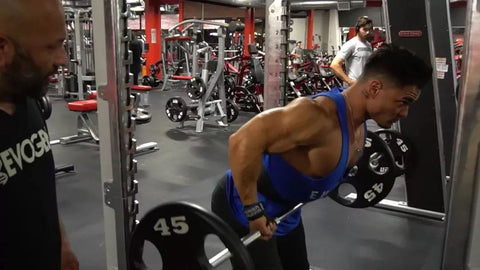
4.Barbell rowing is a great back shoulder and biceps training
Most people choose to do too many isolated movements when training the deltoid and biceps. In fact, this is not very efficient. A wide-grip barbell rowing will make your deltoid muscles more involved.
A back-grip barbell row will have more biceps activation. Multi-joint barbell rowing can load more load than isolated movements (reverse bird, two-head curl), and at the same time increase coordination between muscles, making your muscles more functional and training more Efficient.
What muscles do barbell rows work?
In the barbell rowing exercise, most of the back muscles are trained, the most important are the middle and lower trapezius, rhomboid, latissimus dorsi and deltoid muscles, and it also stimulates many deep muscles. For friends who want to increase the thickness of their backs, rowing is one of the best training exercises.
When the barbell is pulled back, the trapezius muscles contract, and the rhomboid muscles contract at the same time, making our shoulder blades retract; the function of the deltoid posterior bundle is to stretch our shoulder joints back when contracted; as for the latissimus dorsi, It is the active muscle of our upper limb pulling action, which has the function of pulling other people or things closer to the body.
How to do barbell rows?
Preparation
1.Barbell position
There are many starting options for barbell rowing, which can be lifted from the ground, on a rack, or on a bench press. The bench press plan is not recommended, because the stool is too narrow, if the barbell is too heavy, it is easy to bend the barbell bar. If you lift it from the rack, it is recommended to set the height lower than the palm height of the hands in a standing position.
2.Grip distance
Narrow rowing generally uses a grip slightly wider than the shoulder and the same grip distance as the strength lift; wide rowing uses a grip close to the bench press, that is, about 1.5 times the shoulder width.
3.Lift the barbell
No matter where it is lifted from, it is best to complete a deadlift (or stand-up deadlift), adjust it, and then bend the hips and lower them to the proper position. If you start from the top position, stand up straight after lifting the barbell and step back three small steps. There is really no need to step back for several meters. It doesn't make any sense apart from wasting your energy.
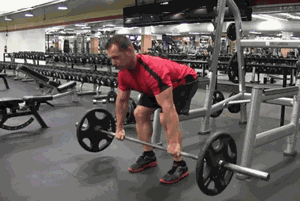
The action begins
1.Lower the barbell
First notice that the back is straight, the spine is in a neutral position, hyperextension (reverse bow) is acceptable, and flexion (bend) is corrected immediately. The position of the barbell has many different opinions. The one I have seen most is that the torso is parallel to the ground and the barbell is as close to the ground as possible. I think this is unreliable. Most people, especially men, cannot achieve a straight back and their torso is parallel to the ground. Women are much more flexible than men, and there are a lot of things they can't do. Therefore, I suggest that we just look at the relative position of the barbell to the body, and place the barbell down to the tibial tuberosity (the slightly protruding piece of the front of the lower leg below the knee socket). If the flexibility is worse than mine, just bend your knees a little more and reach below the knee.
2.Posture of back, feet and knees
The feet are slightly abducted. The knees are toward the toes, and the knee joints are slightly bent. After the lowering is complete, the shoulder blades are completely relaxed, in the abduction position, do not shrug your shoulders.
3.Pull up the barbell
In the narrow rowing, after the barbell is over the knee, lift up along the front of the thigh until it touches the lower abdomen. For wide-distance rowing, the barbell trajectory is almost vertical, with the elbows spread out and lifted until the xiphoid process of the sternum to the belly button. When the two movements are at the top, the forearms are almost vertical.
Several mistakes you may make when barbell rows
1.Wrong preparation posture for barbell rowing
The ready posture for barbell rowing is very important, but there should not be too many people who make this mistake. I count one.
When I first did barbell rowing, I bent over and bent my knees like a deadlift, and then pulled up the barbell... There was no problem in the first half of the journey. My problem was that instead of pulling the barbell up and standing upright, I lifted the barbell. Pull up, and when the body maintains a 45-degree angle, directly start barbell rowing.
In doing so, looking from the mirror, my posture is relatively standard, but in fact, the pressure on my waist is very heavy at this time!
The correct way is to pull up the barbell like a deadlift, stand upright, and then let our knees bend slightly, and then lean forward, keep the body stable, and keep the back flat and the lower back straight, and then start again. Do barbell rowing.

2.When doing barbell rowing, the weight used is too large.
Many people have made this mistake, because everyone has vanity and is afraid that others will look down on it.
But with heavy barbell bench press, many times your arms and back can bear this kind of weight, but your waist can't bear this kind of weight.
When using heavy weights to do barbell bench presses, it not only reduces the intensity of your back training, but also greatly increases the pressure on your waist!
3.The spine is bent when doing barbell rowing (as shown below)

4.When doing barbell rowing, wrist flexion and extension (as shown below).

Novices doing barbell rowing are easier to flex and stretch their wrists, as shown on the left in the picture below.
Please remember that whether you are doing barbell rowing or other rowing actions, your wrists must always be in a neutral position, so that the back of your hands and your forearms are in the same straight line. This will not only ensure safety, but also make you better. Feel the back force well.
5.Raise your head excessively when doing barbell rowing
When doing a lot of fitness exercises, we may all be asked to raise our heads and chests, which is normal.
But when doing barbell rowing, please pay attention, making you stand up does not make you look up!
Your body itself is at a certain angle to the ground. Raising your head too high at this time can easily injure your cervical spine, and also easily cause your waist to bow back!
The correct way is to keep the back of your head in line with your back, and then your eyes are looking diagonally forward.
6.Stand too straight when doing barbell rowing (as shown below)
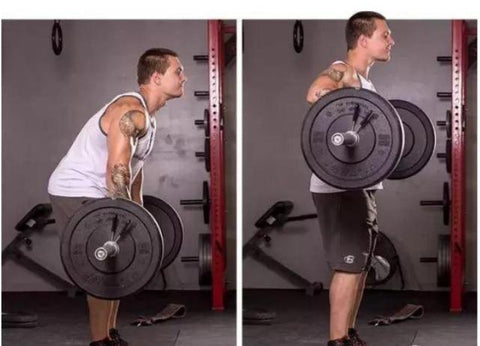
If you stand too straight when doing barbell rowing, your waist will be more comfortable and can carry heavier weight, but if you stand too straight, the main force muscle will become trapezius.
So when doing barbell rowing, what angle is better to keep the body and the ground? Some people say that the body should be parallel to the ground after leaning over... This, to be honest, you can use this posture to do barbell rowing. Generally, you can't find a few in the gym, even if you use an empty bar.
And after leaning over, the body is parallel to the ground, which puts too much pressure on the waist. If you have to do this, I suggest raising the stool and lying on the stool. This is better.
Normally, I think it would be better to keep your body and the ground around 45 degrees.
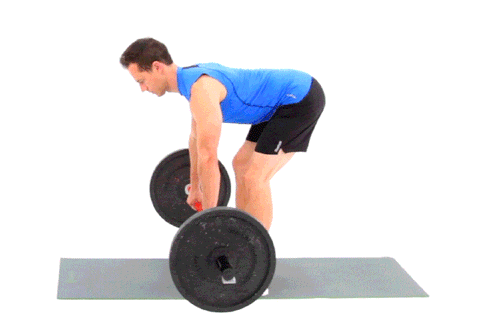
7.When the barbell is rowing, the barbell goes straight up and down
The so-called barbell rowing is said to be a rowing action, and rowing is to row, so it is definitely not straight up and down.
The correct way is to hold the barbell with both hands and pull diagonally towards your abdomen.
8 of the best row variations
- Pendlay Row
- Bent-Over Row
- Dumbbell Row
- Seated Cable Row
- T-Bar Row
- Barbell T-Bar Row
- Barbell Seal Row
- Chest-Supported Row
You just learned how to do a barbell row.
I think this is probably the best one in all the lines, and if I can only choose one of them, I would recommend it.
Fortunately, I don't have to choose one (you don't choose either!). It is worth mentioning that there are more than a dozen other bending and bending changes, you may find that you prefer one or more than regular barbell rows, depending on your anatomy, mobility, equipment selection, preference and injury history.
One disadvantage of the traditional barbell row is that it also requires considerable leg strength, which means that if your legs become stiff due to other exercises, it will be difficult to do this correctly. Therefore, if you want to continue training your back after the quadriceps, hamstrings, and gluteus maximus are hit, these barbell row changes usually work well.
Pendlay Row
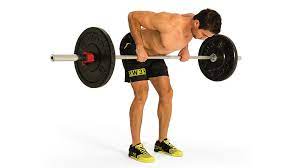
How to: Walk up to a loaded bar and position your feet about shoulder-width apart, with your toes pointed slightly outward. Bend over and grab the bar with a slightly wider than shoulder-width grip with your palms facing toward you. Straighten your back and raise your hips until your back is roughly parallel to the floor.
Pull the barbell to your upper body, touching it anywhere between your lower chest and belly button. Once the bar touches your body, reverse the movement and return it to the floor.
Why: The Pendlay row is similar to the barbell row, except you don’t use your lower body to help hoist the bar off the floor. This means you probably won’t be able to lift as much weight as you do with other row variations, but it also means your lats, traps, and rhomboids do more of the work and you aren’t limited by your lower-body strength.
Bent-Over Row
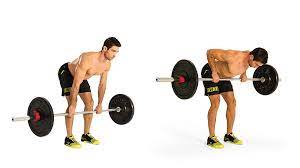
How to: Grab a loaded barbell with an underhand grip (your palms facing away from you) and hold it just below your knees. Without using your legs to build momentum, pull the barbell to your torso, touching it anywhere between the bottom of your rib cage and your belly button. Once the bar touches your body, reverse the movement and return to the starting position.
Why: Many bodybuilders—including Dorian Yates, the inventor of the exercise and six-time Olympia winner—believe the Yates row is superior to the barbell row at training the biceps, traps, and upper back. Many people also find it more comfortable as well.
Dumbbell Row
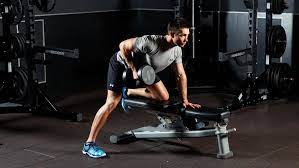
How to: Hold a dumbbell in your right hand. Bend over and put your left hand and left knee on a bench, chair, windowsill, etc. that’s about knee height off the ground. Keep your right foot planted on the floor and let your right arm (the one holding the dumbbell) extend toward the floor.
Keeping your back straight, pull the dumbbell upward until it touches your torso. Return the dumbbell to the starting position. Once you’ve completed the desired number of reps, repeat the process with your left arm.
Why: The main benefits of the one-arm dumbbell row are that it trains each side of your body independently and that you can lift slightly more weight with each arm than you can when doing the barbell row. (That is, if you can lift 200 pounds with both arms during the barbell row, you’ll probably be able to lift 105 pounds or so with one arm during the dumbbell row).
Seated Cable Row
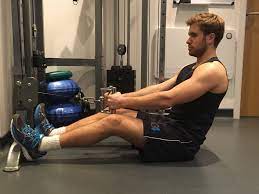
How to: Sit on the pad and place your feet on the foot rest while maintaining a small bend in your knees. Lean forward and grab the handle (you can use whichever handle attachment you want, put I like the close-grip “V” handle), then lean back with your arms stretched in front of you.
Straighten your back and pull the cable toward your stomach. Once your hands touch your torso, reverse the movement and return to the starting position.
Why: The main benefit of the cable row over other row variations is that by using a cable, there’s constant tension on your muscles throughout each rep. This taxes your back muscles slightly differently than other free weight back exercises.
T-Bar Row
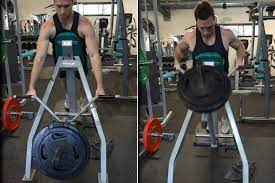
How to: Place your feet on the T-bar row machine footplate, your chest on the pad (if there is one), and grab the handles. Lift the bar off the rest, then pull it toward your chest until your hands are at your sides. Reverse the movement and return to the starting position
Why: Since most t-bar row machines allow you to use a neutral grip (palms facing each other) instead of a pronated grip (palms facing down), the exercise trains your back muscles in a slightly different way than other row variations. Many people also find this grip more comfortable.
Barbell T-Bar Row
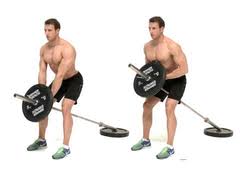
How to: Place one end of an empty barbell in the corner of a room or squat rack and load the other end with weight plates. Straddle the barbell (facing away from the corner) and hook a close-grip handle from a cable row machine under the weighted end of the barbell.
Grab the handles, straighten your back, and slightly straighten your legs so you’re supporting the weight. Keeping your back mostly stationary, pull the bar toward your chest until the weight plate touches your body. Then reverse the movement to return to the starting position.
Why: The barbell corner row cut from the same cloth as the T-bar row. The only difference is you can do the barbell corner row without a T-bar machine, which makes it a good alternative for people who workout in a home gym.
Barbell Seal Row
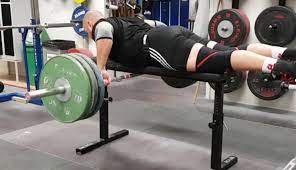
How to: Lie prone on a seal row bench and grab the bar with a slightly wider than shoulder-width grip and your palms facing toward your feet. Pull the barbell toward your upper body until it touches the underside of the bench, then reverse the movement and return to the starting position.
If you don’t have access to a seal row bench, set up a flat, non-adjustable bench on some plyo boxes or aerobics steps and follow the same procedure.
Why: Unlike with other barbell row alternatives, you can’t use momentum to help you lift the weight with the barbell seal row. This forces your back muscles to do more work, making this about as “pure” of a back exercise as you can do.
Chest-Supported Row
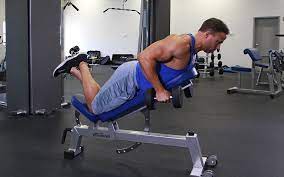
We provide top quality rubber weight plates, cast iron weight plates and weight lifting bar. You can use these equipments to do barbell rows.

